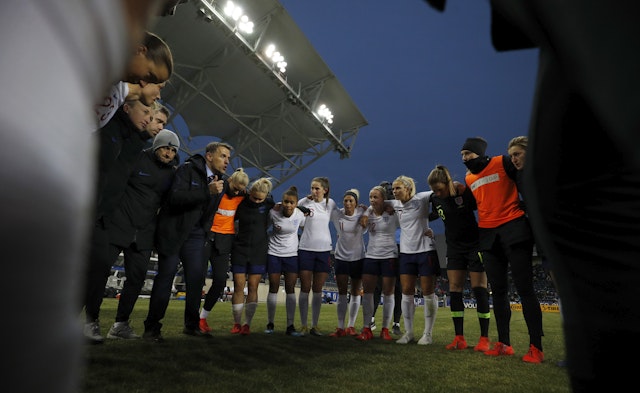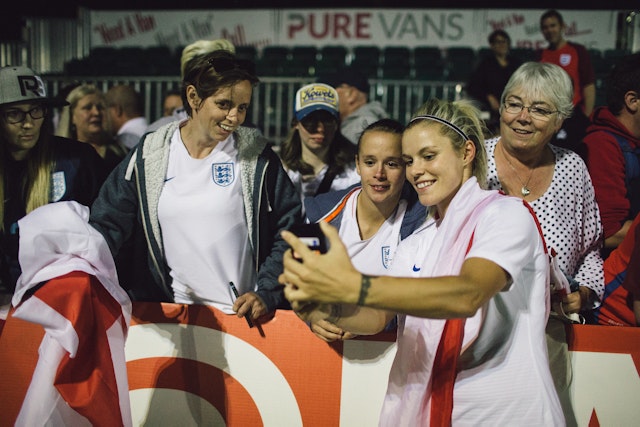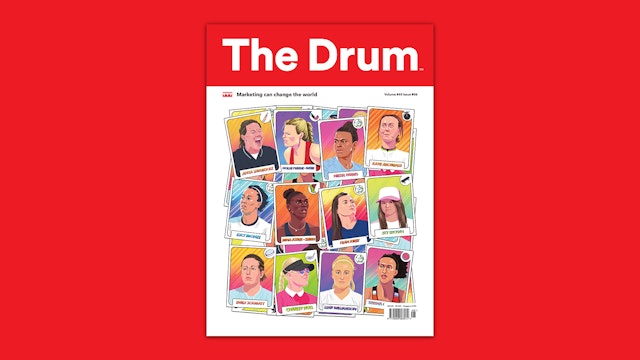
Advertisement

Man City forward Nikita Parris celebrates
Football fans love to see an underdog triumph. Mythologized by the press and commoditized by advertisers, they live on as chest tattoos, their names given to babies. But there is no bigger underdog story than the women’s game’s fight for survival. And at this year’s World Cup, with its unprecedented commercial backing, we will witness the sport’s biggest triumph yet. Get ready to meet your new heroes.
“‘Olé,’ ‘Good v Evil,’ ‘Parklife,’ ‘The Cage...' Figo, Ronaldo, Cantona, Totti...” Paula Bloodworth is humoring me as I rhyme off my favorite-ever Nike football ads, and the players they helped to make household names.
Having endured my excited ramblings, however, the Wieden+Kennedy strategy director, who has worked on Nike’s ‘Nothing Beats a Londoner’ campaign and its upcoming Fifa Women’s World Cup creative, points out a glaring commonality my choices share – the complete absence of women.
“Advertising helped raise up those superstars in the hearts of fans everywhere,” she says, adding that the 2019 World Cup in France gives us the chance to finally do the same for some women. “It’s long overdue.”
If done right, “bringing as much heat as possible”, she says we can create “a whole new generation of role models and finally shift the image of those who stand at the top”.
A typical cut-and-paste job won’t work though, Bloodworth argues. “We can’t ignore the barriers and massive inequalities facing these athletes. This must be recognized and respected. The game is still growing and hasn’t had the funding and attention the men’s game has been gifted for such a long time.”
But while the creative planned around the tournament will differ from what we’ve seen in men’s tournaments, it won’t focus on stars’ personal struggles either. “It’s a different breed of football, so we need to acknowledge and celebrate that.”
This World Cup, Bloodworth concludes, is an opportunity to “get the world excited and champion a new breed of athlete and role model for all to look up to – particularly young girls wanting to play”.

Marzena Bogdanowicz is the head of commercial and marketing for women’s football at the FA, English football’s governing body.
“Football is like England’s religion,” she tells me. “Why then would we only have one World Cup?” Now, she says, the World Cup is on a two-year cycle.
“We have a tipping point and soon people will talk about the Lions [the nickname of the England men’s national team] and Lionesses [the women’s team] in the same way”. A series of upcoming tournaments presents a rare window to rapidly grow support for women’s football.
First, France will host the Fifa Women’s World Cup this summer. National sides will then clash again at the Tokyo 2020 Olympics before football ‘comes home’ to England for the Uefa Women’s Euro 2021 tournament. This England team have three consecutive years of international competition in which to make an impact with fans.
Bogdanowicz is inviting brands to support the FA’s women’s initiatives and recognize that they are more than a bolted-on addition to the men’s game. Smart brands, she argues, can come in at this early stage to help build the credibility of the game, raising professionals’ wages with the profile they can lend. Fans, meanwhile, will be attracted to inexpensive matches that are more inclusive and will more likely result in after-match meet-and-greets with players, many of whom are keen to cultivate fandoms.
“There’s been a massive societal change in perception. It is OK for girls to play. The future of football is female,” she says. Just days ago the BBC launched its trailer for the Women's World Cup - it has acquired the rights to all 52 games.
Attendances are generally getting higher. In March, 60,739 fans attended Atletico Madrid v Barcelona – a global record attendance at club level (albeit at €5 a ticket, with many also given away free).
On a national level, the 2015 Women’s World Cup in Canada boasted an average attendance of 26,029 a game, with the Canada v England quarter-final peaking at 54,027.
And there was good news on the media side. Broadcaster Fox attracted 8.4 million viewers to Germany’s semi-final defeat at the boots of the United States.
The largest US TV soccer audience is currently held by the women’s team, not the men’s.
Steve Martin is excited by the “surge of momentum” in women’s sport. The global chief executive of M&C Saatchi Sport and Entertainment hasn’t seen anything like it in his 15 years at the agency, or in the five years he was heading up PR for Adidas. There’s been more briefs over the past 18 months than ever before.
“More brands want to be in this space. Every level of men’s football is cluttered. There are so many brands trying to target the same audience, so the opportunity around women’s football is extraordinary. But you have to get it right.”
Martin’s football experience includes helping Uefa build its women’s football marketing initiatives. The sport was initially targeted at women but evolved to encapsulate parents and families. “It needs to become part of popular culture and the new norm,” he says. “It can’t just be women preaching to women.”
On how to fund the game, he jokingly suggests sparking a brand war between Nike and Adidas. Both brands have made strides into the space already and may come to blows before long, as they have over the men’s game.
Raising the stakes, he concludes: “There isn’t much great creative out there yet; whoever lands a big spot this summer will be the winner.”

Visa’s sponsorship fees for women’s Fifa and Uefa competitions now match what it put into the men’s 2018 World Cup in Russia. It’s a significant increase and demonstrates just how important the sport is to the financial brand.
Head of sponsorship Stephen Day rationalizes the investment, saying: “Visa is for everyone, everywhere, and women’s football is a way for us to talk about acceptance and inclusion – values that are right at our heart. We can talk on a very broad platform and football is a very engaging platform.”
He explains that Visa identified a self-perpetuating cycle that was hampering the game – lack of investment prompted low TV coverage, which in turn stymied the advancement of players as role models and weakened the level of competition.
“We broke that cycle and put some money in, but it takes a few big sponsors to do that.”
At the 2019 World Cup, the brand will share the untold stories of its roster of stars, including the struggles they’ve overcome. It differs to the approach W+K and Nike appear to be taking.
In comparison to their male counterparts, he says the players are “far more approachable and interesting – and people want to hear those stories”. One story Visa will tell is that of Manchester City and England forward Nikita Parris. Day pictures the scenes (and the brand uplift) from a potential World Cup-winning goal from the star.
Speaking days after his club overcame Chelsea in the Women’s FA Cup semi-final (a BBC One broadcast that was unfortunately cannibalized by Tiger Woods’ Masters masterclass on BBC Two), Gavin Makel, head of women’s football at Manchester City, would also like to see Parris put away a glorious match-winning goal.
For almost six years he’s built the women’s football operation at the club, handling everything from player recruitment and marketing to commercial, finance management and match-day operations. The club recently took a big step toward integrating the men and women’s sides with its ‘Same City, Same Passion’ campaign. Particularly appealing is the social media and commercial crossover from the merger.
“It shows how we approach the game and it was an opportunity to convey that message externally,” says Makel.
“For five years, we marketed and commercialized the women’s team through trial and error. There are a few schools of thought, but what’s worked for us is existing partners jumping on board and showing enthusiasm, desire and commitment to grow the game.”
Over time, City have built an audience, though it’s not what many might expect. “It was originally marketed to families and young girls, but now we know a much wider demographic is interested. The gender split is generally 50/50. This data now helps when we speak to commercial partners – they know who they are talking to.”
Now there is an opportunity to attract female-facing brands without past involvement in football. Theoretically, this could broaden the pot supporting the global game. However, it is still rare. Avon made a historic move in 2017, exclusively sponsoring Liverpool Ladies. Then, in April this year, Boots finalized partnerships with England, Scotland, Northern Ireland, the Republic of Ireland and Wales.
Makel warns that courting only female-facing brands could “silo the audiences” – not that he wouldn’t be interested if they too came to the negotiating table.
Paolo Nieddu is the global head of strategy at football publisher-cum-broadcaster Copa90. From a media perspective, he thinks titles like Copa90 need to treat female athletes with equal reverence and integrate their content. Recently unearthed sexist tweets from a contributor underlined the need for this commitment.
Nieddu says: “There will be moments in this World Cup that could inspire a whole generation. It is not just about women, it is about everyone.”
Copa 90’s brief is simple: “To give people a reason to give a shit about the Women’s World Cup.”
“We need to break down the barriers around a lack of connection with men.” Many simply don’t know enough about the players and the teams to get involved, he says. “We have to create that content and that hype and give the players the reverence.”
For James Dickens, global editor-in-chief at football website Goal, on-pitch triumphs have already driven surges of interest in its women’s football content. When the Netherlands won the 2017 Uefa Women’s Championship, traffic to both the Dutch edition of Goal and Voetbalzone (both owned by Dazn Media) spiked.
“You could expect the same lift if England, the US, Germany or France were to win too.”
In fact, Dickens is preparing for it. The World Cup will be used by Goal and Dazn Media as a “springboard for the wider coverage of the women’s game”, which is now integrated with their men’s output. And then there's been an investment in flowing features telling the stories of the game's biggest icons.
Dickens adds: “We recognize that there’s still a lot of education to be done and we expect this content and the tournament itself to act as a platform, both educating and exciting our fans for what should be a fantastic World Cup. Its potential beyond is huge for us, with digital media coverage and what our OTT platform can provide individually and in tandem.”
It appears all of the pieces are falling into place for the sport. But, as was stressed by most of the interviewees, this only marks the start of the journey. Now that many female athletes have the commercial backing to fully commit to the sport, they can write their own stories and inspire a whole new generation of girls and boys.
Football’s pantheon should begin to afford places to its female stars this summer. If it doesn’t, deeper societal questions will arise.
This feature first appeared in The Drum magazine's June issue. For our Future of Sport issue, we talk to Wieden+Kennedy, the FA and Visa about how brands are elevating sporting heroines ahead of the World Cup. We meet Formula E racing teams, fitness brands betting on startups and NFL veterans reinventing themselves as media moguls. Get your copy here.
